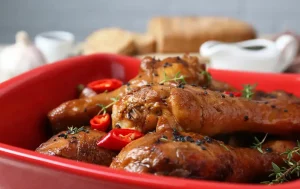Soy Glazed Chicken is a mouthwatering dish that effortlessly combines the rich flavors of soy sauce with the tender juiciness of chicken. This culinary delight has gained popularity worldwide for its delectable balance of sweet, salty, and umami flavors, making it a favorite among those who appreciate the subtleties of Asian-inspired cuisine. Whether served as a main course for family dinners or as a savory appetizer at gatherings, Soy Glazed Chicken promises a flavor-packed experience that leaves diners craving more.
Choosing the Right Chicken Cut
Selecting the appropriate cut of chicken is crucial for achieving the perfect texture and flavor absorption in Soy Glazed Chicken. Thighs and drumsticks are often preferred for their juiciness and ability to remain tender and flavorful after cooking. However, breast pieces can also be used for a leaner option, ensuring they are not overcooked to maintain moisture. The key is to use bone-in, skin-on pieces to maximize flavor and achieve a crispy exterior that complements the sticky soy glaze.
Crafting the Perfect Soy Glaze
The soy glaze is the heart of this dish, with its intricate blend of ingredients contributing to the overall depth of flavor. A combination of soy sauce, brown sugar, garlic, ginger, and a hint of sesame oil creates a rich and aromatic sauce that perfectly coats the chicken. For an added kick, a splash of rice vinegar or a squeeze of fresh lime juice can introduce a bright acidity that balances the sweetness. Simmering the mixture until it thickens ensures a sticky, glossy finish that adherently clings to the chicken pieces.
Marinating for Depth of Flavor
Marinating the chicken in a portion of the soy glaze enhances the flavor and tenderness of the meat. Allowing the chicken to marinate for at least an hour, or ideally overnight, gives the flavors time to penetrate deeply, resulting in a more cohesive and robust taste profile. This step is essential for infusing the chicken with the complex flavors of the glaze, setting the stage for a dish that is rich in umami and savory notes.
Baking to Perfection
Baking is a preferred method for cooking Soy Glazed Chicken, as it evenly cooks the meat while allowing the skin to become deliciously crispy. Preheating the oven and arranging the marinated chicken pieces on a wire rack over a baking sheet helps to ensure even air circulation and crisping. Basting the chicken with additional glaze halfway through cooking caramelizes the surface, adding a layer of flavor complexity. The chicken is ready when it’s beautifully bronzed, and the glaze has formed a sticky, glossy coating that’s irresistibly appealing.
Serving Suggestions and Pairings
Soy Glazed Chicken is a versatile dish that pairs beautifully with a variety of sides. Steamed jasmine or basmati rice makes a simple yet perfect accompaniment, soaking up the extra glaze and balancing the richness of the chicken. For a lighter option, a side of stir-fried vegetables or a crisp green salad complements the savory notes of the dish. To complete the meal, consider serving it with a cold, crisp beer or a glass of Riesling, which pairs wonderfully with the sweet and salty flavors of the glaze.
Enhancing Flavor with Garnishes
Adding garnishes to Soy Glazed Chicken not only enhances its visual appeal but also introduces additional layers of flavor and texture. Sprinkling toasted sesame seeds over the finished dish adds a nutty crunch that contrasts beautifully with the tender meat and sticky glaze. A scattering of finely chopped green onions or cilantro can provide a fresh, herbaceous note that cuts through the richness of the soy sauce. For those who enjoy a bit of heat, thinly sliced chili peppers offer a spicy kick that complements the sweet and savory glaze.
Adapting the Recipe for Dietary Restrictions
Soy Glazed Chicken can easily be adapted to meet various dietary restrictions without compromising on flavor. For a gluten-free version, simply substitute soy sauce with a gluten-free tamari or coconut aminos. To reduce the sugar content, honey or maple syrup can be used as natural sweeteners in place of brown sugar, adjusting the quantity to taste. For a vegetarian or vegan adaptation, firm tofu, tempeh, or cauliflower florets can replace chicken, following the same marinating and baking steps to achieve a similar texture and flavor profile.
Exploring Variations of Soy Glaze
The versatility of the soy glaze allows for numerous variations that can cater to different palates and occasions. Adding a splash of mirin or sake introduces a subtle sweetness and depth, while incorporating hoisin sauce can give the glaze a richer, more complex flavor. For a smoky twist, a few drops of liquid smoke or a pinch of smoked paprika can be mixed into the glaze before marinating. Experimenting with these variations can transform the dish, offering new taste experiences with each preparation.
Techniques for Achieving Crispy Skin
Achieving crispy skin on Soy Glazed Chicken is essential for texture contrast and flavor. The key is to ensure the skin is thoroughly dried before marinating, as excess moisture can prevent it from crisping up in the oven. Broiling the chicken for the last few minutes of cooking can also help to crisp the skin further, but watch closely to avoid burning the glaze. Alternatively, searing the chicken skin-side down in a hot skillet before baking can lock in juices and start the crisping process early.
Incorporating Soy Glazed Chicken into Meals
Soy Glazed Chicken is not only a stand-alone star but also a versatile component that can elevate various meals. Shredded and tossed in salads or wraps, it adds a savory, umami-packed protein option. It can also be sliced and served atop noodle bowls or rice dishes for a complete meal that’s rich in flavors and textures. The adaptability of Soy Glazed Chicken makes it a valuable recipe in any cook’s repertoire, capable of enhancing weeknight dinners, special occasions, and everything in between.
Maximizing Flavor Through Marination Time
The depth of flavor in Soy Glazed Chicken is significantly enhanced by the duration of marination. Allowing the chicken to marinate overnight in the refrigerator not only deepens the umami qualities of the soy sauce but also tenderizes the meat, ensuring that every bite is succulent and rich in flavor. If time is limited, a minimum of one hour of marination can still impart a robust taste, but the longer the marination, the more pronounced the flavors will be.
Creative Serving Ideas for Entertaining
When entertaining, presentation and creativity in serving Soy Glazed Chicken can leave a lasting impression on your guests. Consider skewering marinated chicken pieces and grilling them for a delightful twist on traditional yakitori. Serving the chicken atop a bed of steamed jasmine rice in individual bowls, garnished with sesame seeds and green onions, transforms the dish into an elegant entrée. For a casual gathering, Soy Glazed Chicken sliders with a slaw of cabbage and carrots provide a fun, handheld option that’s sure to please a crowd.
Pairing Beverages to Complement the Dish
Selecting the right beverage to accompany Soy Glazed Chicken can enhance the dining experience by balancing the dish’s rich flavors. A light, crisp beer such as a pilsner or a lager contrasts nicely with the savory glaze, cleansing the palate between bites. For wine enthusiasts, a chilled Riesling or Gewürztraminer with its fruity notes and slight sweetness pairs beautifully with the complexity of the soy and ginger. For a non-alcoholic option, a sparkling ginger lemonade offers a refreshing and zesty complement to the dish.
Utilizing Leftovers in Creative Ways
Leftover Soy Glazed Chicken is incredibly versatile and can be repurposed into new meals. Sliced and added to stir-fried vegetables, it creates a quick and flavorful weeknight dinner. Chopped chicken can also be incorporated into Asian-inspired salads, providing protein and a burst of flavor. For a comforting soup, shred the chicken and simmer it in a broth with noodles, bok choy, and mushrooms for a satisfying meal that makes the most of the delicious leftovers.
Celebrating the Global Appeal of Soy Glazed Chicken
Soy Glazed Chicken not only delights the palate but also celebrates the global appeal of soy sauce-based dishes. Its popularity transcends cultural boundaries, showcasing the universal love for flavors that are at once sweet, salty, and savory. By incorporating elements from various cuisines, such as using different herbs, spices, or cooking methods, Soy Glazed Chicken becomes a culinary journey, inviting diners to explore the rich tapestry of global flavors from the comfort of their own kitchens.
The Importance of High-Quality Soy Sauce
Choosing a high-quality soy sauce is pivotal to the overall taste of Soy Glazed Chicken. Artisan or traditionally brewed soy sauces offer a depth of flavor that supermarket varieties often can’t match. These sauces undergo a natural fermentation process, developing a complex profile of flavors that enhances the dish significantly. Experimenting with different types of soy sauce, including light, dark, or even sweet soy sauce, can introduce a range of tastes and nuances to the glaze, allowing for a more personalized and refined dish.
Mastering the Baking Technique
Achieving the perfect bake for Soy Glazed Chicken requires attention to temperature and timing. Preheating the oven ensures that the chicken cooks evenly from the start, while using a meat thermometer guarantees that the chicken reaches the safe internal temperature without becoming dry. Basting the chicken with additional glaze during the baking process not only adds more flavor but also contributes to a sticky, caramelized exterior that is visually appealing and delicious.
Incorporating Vegetables for a Balanced Dish
Adding vegetables to the baking tray with Soy Glazed Chicken turns it into a complete, balanced meal. Vegetables like broccoli, bell peppers, and carrots not only soak up the flavorful glaze but also add color, nutrition, and texture to the dish. Roasting vegetables alongside the chicken simplifies meal preparation and ensures that the entire meal is infused with the savory sweetness of the soy glaze.
Exploring Soy Glaze as a Versatile Condiment
The soy glaze used in Soy Glazed Chicken can be repurposed as a versatile condiment for various dishes. It serves as an excellent dipping sauce for dumplings or spring rolls, adding a rich umami kick. The glaze can also be brushed on grilled vegetables or tofu, providing a savory coating that enhances these simpler ingredients. Keeping a batch of the soy glaze on hand opens up endless possibilities for elevating everyday dishes with minimal effort.
Engaging the Senses with Soy Glazed Chicken
Soy Glazed Chicken is not just a feast for the taste buds but engages all the senses. The aroma of the chicken marinating and baking fills the kitchen with inviting smells that stimulate appetite and anticipation. Visually, the glossy sheen of the glaze against the golden brown chicken is a delight, while the sizzle of the chicken as it cooks adds an auditory dimension to the cooking experience. The combination of textures from the crispy skin to the tender meat completes the sensory experience, making Soy Glazed Chicken a dish that is as enjoyable to prepare as it is to eat.
FAQs about Soy Glazed Chicken
Q1: Can I make Soy Glazed Chicken on the grill? A1: Yes, you can grill Soy Glazed Chicken for a smoky flavor. Just ensure the grill is medium-hot and brush the chicken with extra glaze during the last few minutes of grilling to avoid burning.
Q2: What can I substitute for soy sauce if I’m avoiding soy? A2: For a soy-free alternative, coconut aminos make a great substitute, offering a similar umami flavor with a lower sodium content.
Q3: Is this recipe suitable for meal prep? A3: Absolutely, Soy Glazed Chicken is excellent for meal prep. Cook in advance, store in the refrigerator, and reheat for quick and flavorful meals throughout the week.
Q4: How can I ensure the chicken is fully cooked without drying it out? A4: Use a meat thermometer to check that the chicken has reached an internal temperature of 165°F (74°C). This ensures it’s safely cooked without overdoing it.
Q5: Can I use boneless chicken breasts instead of thighs? A5: Yes, boneless chicken breasts can be used for a leaner option. Just adjust the cooking time as they may cook faster than thighs.
Conclusion
Soy Glazed Chicken stands as a testament to the versatility and depth of flavor that can be achieved with simple ingredients. Through marination, careful preparation, and thoughtful cooking techniques, this dish offers a symphony of flavors that delight the senses. Whether enjoyed on its own, as part of a larger meal, or repurposed into creative leftovers, Soy Glazed Chicken is a recipe that speaks to the heart of flavorful, satisfying cooking. Its adaptability to different cooking methods and dietary needs ensures that everyone can enjoy the rich, umami-packed goodness it has to offer. Dive into the world of Soy Glazed Chicken, and let it inspire your culinary adventures, bringing a taste of global cuisine right to your table.
Print
Soy glazed chicken
- Author: recipstep
- Total Time: 45 minutes
- Yield: Serves 4
- Diet: Gluten Free
Description
Soy Glazed Chicken is a delectable dish that marries the savory depth of soy sauce with the natural sweetness of honey, creating a tantalizing glaze that coats tender, juicy chicken pieces. This recipe offers a perfect balance of flavors, making it a hit for any meal.
Ingredients
– 4 boneless, skinless chicken breasts (approximately 600 grams)
– 80 ml (1/3 cup) soy sauce
– 60 ml (1/4 cup) honey
– 30 ml (2 tablespoons) rice vinegar
– 15 ml (1 tablespoon) sesame oil
– 3 garlic cloves, minced
– 15 grams (1 tablespoon) grated fresh ginger
– 5 grams (1 teaspoon) cornstarch (optional, for thickening)
– Chopped green onions and sesame seeds for garnish (optional)
Instructions
1. In a bowl, combine the soy sauce, honey, rice vinegar, sesame oil, minced garlic, and grated ginger. Stir well until the honey is dissolved.
2. If desired, pound the chicken breasts to an even thickness for quicker and more even cooking.
3. Place the chicken breasts in a shallow dish or a resealable plastic bag. Pour the soy sauce mixture over the chicken, ensuring it is well coated. Marinate in the refrigerator for 1 hour (optional) to allow the flavors to develop.
4. Preheat the grill or a large skillet over medium-high heat.
5. If using a skillet, add a small amount of oil to prevent sticking. Place the marinated chicken breasts in the skillet or on the grill.
6. Cook the chicken for approximately 6-8 minutes per side, or until the internal temperature reaches 75°C (165°F) and the chicken is cooked through.
7. While the chicken is cooking, pour the remaining marinade into a small saucepan. Bring it to a boil and let it simmer for a few minutes to reduce and thicken. If desired, mix the cornstarch with a little water to create a slurry and add it to the saucepan to further thicken the glaze.
8. Once the chicken is cooked, remove it from the heat and brush or drizzle the soy glaze over the chicken.
9. Garnish with chopped green onions and sesame seeds, if desired.
10. Serve the soy glazed chicken with steamed rice or your favorite side dishes.
Please note that the quantities provided are approximate and can be adjusted according to your preference. The calorie count may vary depending on the specific brands and ingredients used.
Notes
- For a gluten-free version, use tamari instead of soy sauce.
- Adjust the sweetness by adding more or less honey to taste.
- Marinating the chicken in the soy sauce mixture for an hour before cooking can enhance the flavors.
- Prep Time: 10 minutes
- Cook Time: 35 minutes
- Category: Main Dish
- Method: Baking
- Cuisine: Asian-Inspired
Nutrition
- Calories: 350
- Sugar: 9g
- Sodium: 800mg
- Fat: 20g
- Saturated Fat: 5g
- Carbohydrates: 12g
- Fiber: 0g
- Protein: 30g
- Cholesterol: 140mg





